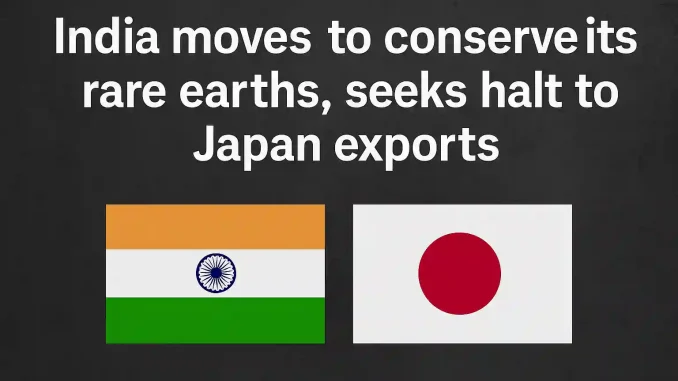
In a significant policy shift that underscores the growing importance of critical minerals in geopolitical and economic strategy, the Government of India is reportedly taking steps to curb the export of rare earth elements (REEs) to Japan and other countries. The move comes amid escalating concerns over the global supply chain for these strategic resources, particularly as India aims to strengthen its own electric vehicle (EV) and green energy sectors.
Sources familiar with the matter suggest that New Delhi is evaluating a proposal to temporarily halt or significantly restrict exports of rare earth ores and intermediate products to foreign nations—chief among them Japan, which has long depended on Indian rare earths to offset its reliance on Chinese supplies.
What Are Rare Earths and Why Do They Matter?
Rare earth elements—like neodymium, dysprosium, lanthanum, and cerium—are not particularly rare in terms of global availability but are difficult and environmentally costly to extract and refine. These 17 elements are critical for the manufacturing of permanent magnets, batteries, semiconductors, wind turbines, defense systems, and various components in smartphones and electric vehicles.
Although China controls around 85–90% of global rare earth processing, India is one of the few other countries with substantial reserves. The country’s deposits are mostly found along the coastal states of Odisha, Andhra Pradesh, Tamil Nadu, and Kerala. Until now, India exported a significant portion of its rare earth output, particularly to Japan, under agreements dating back more than a decade.
The Strategic Rationale Behind the Shift
Several factors are prompting India to reconsider its export commitments:
1. National Security and Technological Sovereignty
With the rise of electric mobility, renewable energy, and indigenous defense production, rare earths have become a cornerstone of India’s long-term strategic vision. Ensuring a stable domestic supply is now seen as essential for future-proofing India’s technological growth.
2. China’s Clampdown on Rare Earth Exports
Recent restrictions by Beijing on the export of high-grade rare earth magnets and associated materials have put additional pressure on countries like India to secure their own resources. India imports many refined rare earth products and components from China, even though it exports raw ores abroad—creating a strategic contradiction.
3. Domestic Industrialization Push
Under schemes like Make in India, PLI (Production-Linked Incentives), and the recently announced Critical Minerals Mission, the Indian government is actively encouraging the establishment of rare earth refining, magnet manufacturing, and component industries within the country. Exporting raw materials while importing finished products undermines this effort.
Implications for India-Japan Relations
Japan has been one of India’s closest strategic partners in Asia. Following China’s rare earth embargo on Japan in 2010, Tokyo turned to India as a reliable alternative source. The two countries signed several MoUs for rare earth collaboration, with Indian Rare Earths Ltd (IREL) and Japanese firm Toyota Tsusho at the center of joint extraction and export projects.
Any decision to restrict exports is likely to test this partnership, though officials say the change is not aimed at Japan per se.
“This is not about geopolitical signaling,” said a senior government official speaking on condition of anonymity. “It’s about building internal resilience. We value our ties with Japan and will ensure that existing commercial agreements are honored wherever possible.”
Experts also note that India could continue sending small, value-added rare earth shipments while limiting the export of raw ores and unprocessed materials.
Industry Reaction: Cautious Optimism
Indian industry players and policy analysts have largely welcomed the move as long overdue. The domestic rare earth sector has long complained of underutilization, policy confusion, and competition from cheap imports.
“India must do what China did—restrict exports of raw materials and invest heavily in downstream capacity,” said Ashok Sharma, Managing Director of a magnet manufacturing startup in Bengaluru. “We’ve already lost the semiconductor race. Let’s not make the same mistake with critical minerals.”
The Federation of Indian Mineral Industries (FIMI) has also advocated for a reclassification of rare earths as strategic minerals, warranting special protection and centralized policy oversight, possibly under a dedicated Ministry of Critical Materials.
Challenges Ahead: Infrastructure, Expertise, and ESG
While the policy shift is strategic, its success depends on India’s ability to ramp up rare earth processing and value-added manufacturing. Currently, most of India’s rare earth output is processed in limited quantities by government-controlled entities like IREL.
Key challenges include:
- Lack of refining capacity for high-purity magnets
- Scarcity of skilled labor in this specialized sector
- Environmental concerns associated with rare earth mining, including radioactive waste
- Slow private sector entry due to regulatory bottlenecks
To address these gaps, the government is considering new incentives under the PLI scheme, as well as inviting foreign technology partnerships (excluding Chinese firms) for joint ventures in refining and component production.
The Road Ahead: Toward Rare Earth Sovereignty
In the backdrop of global tensions and shifting trade alliances, rare earths are no longer just a commodity—they are a currency of power. India’s decision to limit exports to conserve its reserves signals a coming of age in its strategic industrial thinking.
According to a recent report by NITI Aayog, India’s domestic rare earth demand could triple by 2030, driven by EVs, electronics, aerospace, and defense. Ensuring that this demand is met by local resources will be crucial if India is to achieve self-reliance in key technologies and avoid being held hostage to foreign supply chains.
Leave a Reply